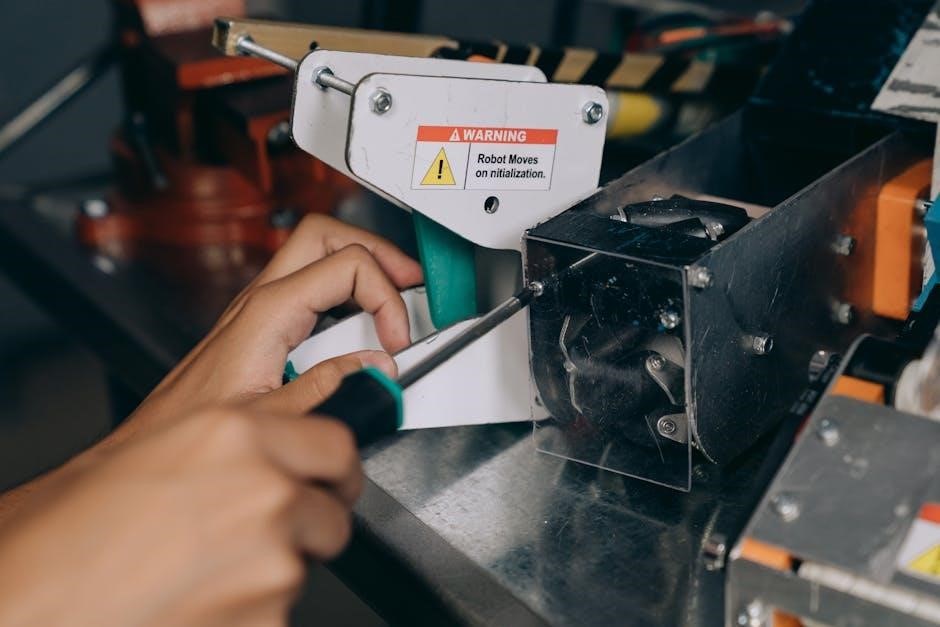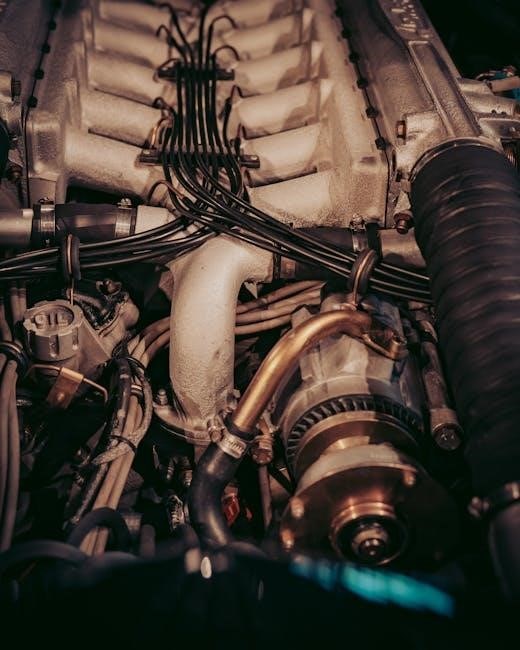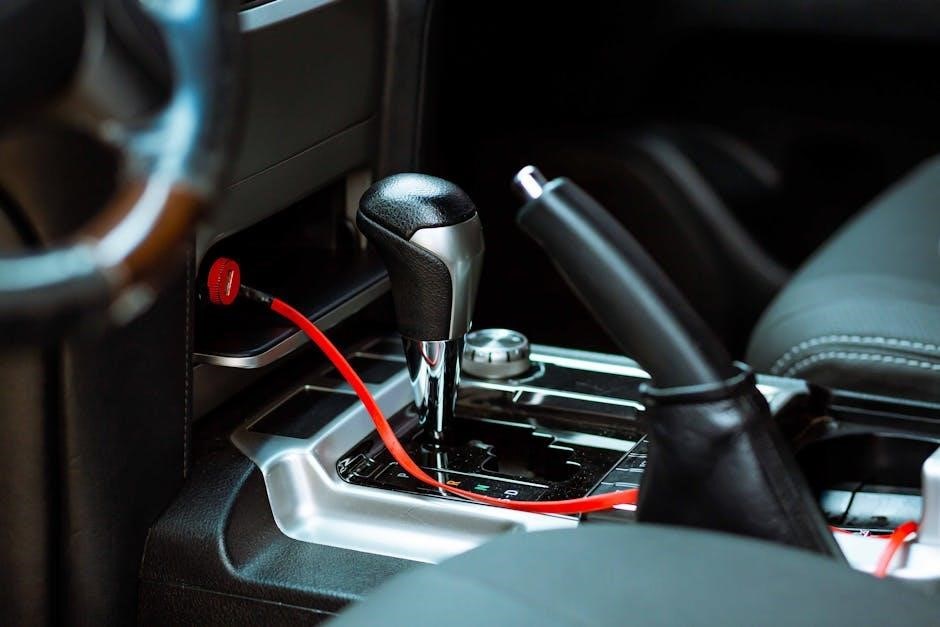Manual transmission components include various parts like gears and shafts, arranged to provide torque and speed ratios, enabling smooth transmission of power from the engine to the wheels using hydraulic parts.
Overview of Manual Transmission
Manual transmission is a type of transmission that utilizes a driver-operated clutch for engagement and disengagement via the foot pedal, along with a hand lever and gear selector, regulating torque transfer. The manual transmission system is designed to transmit power from the engine to the wheels, allowing the vehicle to move. This system is essential for efficient operation and maintenance of a vehicle. The manual transmission components work together in a precise and coordinated manner to provide smooth transmission of power. The system is widely used in various types of vehicles, including cars, trucks, and buses. The manual transmission is a critical component of a vehicle’s powertrain, and its proper functioning is essential for the vehicle’s overall performance and efficiency. The system is also known for its simplicity and reliability, making it a popular choice among vehicle manufacturers and drivers.

Key Components of Manual Transmission
Manual transmission components include gears, shafts, and hydraulic parts, working together to transmit power from the engine to the wheels smoothly and efficiently always.
Clutch Disc and its Function
The clutch disc is a crucial component in manual transmission, responsible for transmitting torque from the engine to the transmission system. It works in conjunction with the clutch pedal, which is operated hydraulically. When the clutch pedal is pressed, the clutch disc disengages, allowing the driver to shift gears smoothly. The clutch disc is designed to withstand high friction and heat, ensuring reliable performance and longevity. Its function is to connect and disconnect the engine from the transmission, enabling the driver to control the flow of power to the wheels. The clutch disc plays a vital role in the overall operation of the manual transmission, and its proper functioning is essential for efficient and safe driving. The clutch disc is typically made of a durable material, such as friction-lined steel, and is designed to provide consistent performance over time.
Clutch Pedal and its Operation
The clutch pedal is a vital component in manual transmission, responsible for controlling the engagement and disengagement of the clutch disc. It is typically operated by the driver’s foot and is connected to the clutch disc through a hydraulic or mechanical linkage. When the clutch pedal is pressed, it disengages the clutch disc, allowing the driver to shift gears smoothly. The clutch pedal’s operation is critical to the smooth functioning of the manual transmission, and its proper use is essential for efficient and safe driving. The pedal’s movement is typically smooth and progressive, allowing the driver to control the amount of clutch engagement. The clutch pedal’s design and operation vary depending on the vehicle and transmission type, but its fundamental function remains the same. The clutch pedal is a critical interface between the driver and the transmission, enabling precise control over the vehicle’s movement.

Understanding Manual Transmission Parts
Manual transmission parts work together to transmit power from engine to wheels using hydraulic components and gears smoothly always.
Gears and their Role in Manual Transmission
Gears play a crucial role in manual transmission, enabling the vehicle to move at varying speeds. The gear system consists of multiple gears, each with a specific ratio, allowing the driver to shift gears manually. This is achieved through the use of a gear selector and a clutch pedal, which work in conjunction to engage and disengage the gears. The gears are responsible for transmitting power from the engine to the wheels, and their ratios determine the speed and torque of the transmission. In a manual transmission system, the gears are typically arranged in a specific pattern, with lower gears providing more torque and higher gears providing more speed. The driver must use the clutch pedal and gear selector to shift gears smoothly and efficiently, taking into account the vehicle’s speed and the terrain it is being driven on.
Shift Fork and Synchronizer Components
The shift fork and synchronizer components are critical parts of a manual transmission system, working together to facilitate smooth gear shifting. The shift fork is a mechanical component that engages and disengages the gears, while the synchronizer ensures that the gears are properly aligned before engagement. The synchronizer components use friction to match the speed of the gear to be engaged, allowing for smooth and quiet shifting. The shift fork and synchronizer work in conjunction to provide precise control over the gear shifting process, enabling the driver to shift gears quickly and efficiently. The design and operation of these components are crucial to the overall performance and reliability of the manual transmission system, and are typically designed to withstand the stresses and demands of high-performance driving. Proper functioning of these components is essential for smooth and efficient gear shifting.
Manual Transmission System and its Layout
Manual transmission system layout includes gears, shafts, and bearings, arranged to transmit power from the engine to the wheels efficiently using hydraulic parts and mechanical components.
Output Shaft and its Importance
The output shaft is a crucial component of the manual transmission system, responsible for transmitting power from the transmission to the driveshaft and eventually to the wheels. It plays a vital role in the overall functioning of the vehicle, enabling it to move forward, reverse, and change gears smoothly. The output shaft is typically connected to the gearbox and is designed to withstand the stresses and strains of transmitting power to the wheels. Its importance cannot be overstated, as a faulty output shaft can lead to significant problems with the vehicle’s performance and reliability. The output shaft is usually made of high-strength materials and is designed to provide a smooth and efficient transfer of power. It is an essential part of the manual transmission system and requires regular maintenance to ensure optimal performance. Proper functioning of the output shaft is essential for the vehicle’s overall health.

Types of Manual Transmission
Manual transmissions have various types, including automated and manual, with different designs and functionalities, providing unique driving experiences and advantages, using hydraulic parts and gear systems efficiently always.
Automated and Manual Transmission Comparison
Automated and manual transmissions have distinct differences in terms of driver engagement and control. Manual transmissions require the driver to manually shift gears using the clutch pedal and gear selector, providing a more engaging driving experience. In contrast, automated transmissions automatically shift gears without driver input, providing a more convenient and effortless driving experience. The comparison between automated and manual transmissions reveals that manual transmissions offer better fuel efficiency and performance, while automated transmissions provide smoother acceleration and reduced driver fatigue. The choice between automated and manual transmissions ultimately depends on personal preference and driving style. Understanding the differences between these two types of transmissions can help drivers make informed decisions when selecting a vehicle. Overall, both automated and manual transmissions have their unique advantages and disadvantages, catering to different driving needs and preferences.

Location and Function of Transmission in a Vehicle
Transmission is typically located in front of a vehicle’s chassis, enabling engine disengagement from driving wheels when stopped, allowing engine rest and swift acceleration using hydraulic parts smoothly.
Transmission Diagram and its Significance
A transmission diagram is a visual representation of the components and their relationships in a manual transmission system, showing how power is transmitted from the engine to the wheels. The diagram illustrates the layout of gears, shafts, and other parts, helping to understand the flow of power and torque. It is a crucial tool for technicians and engineers, allowing them to diagnose and repair problems, as well as design and optimize new transmission systems. The diagram also provides a clear understanding of the mechanical advantages and disadvantages of different transmission configurations, enabling the development of more efficient and reliable systems. By studying the transmission diagram, one can gain a deeper understanding of the complex interactions between the various components and how they work together to provide smooth and efficient power transmission. This knowledge is essential for maintaining and improving manual transmission systems.
